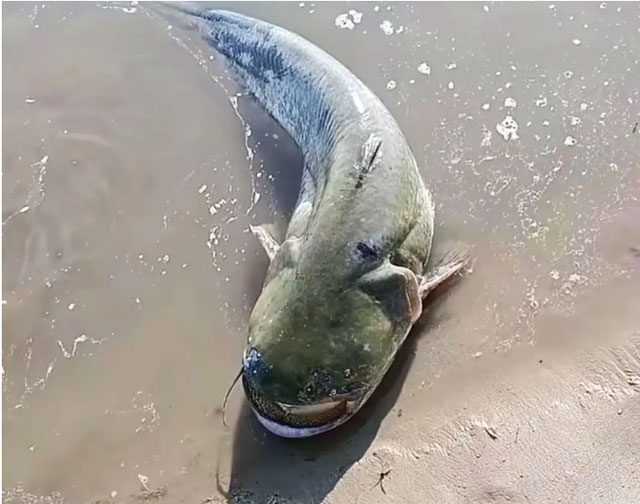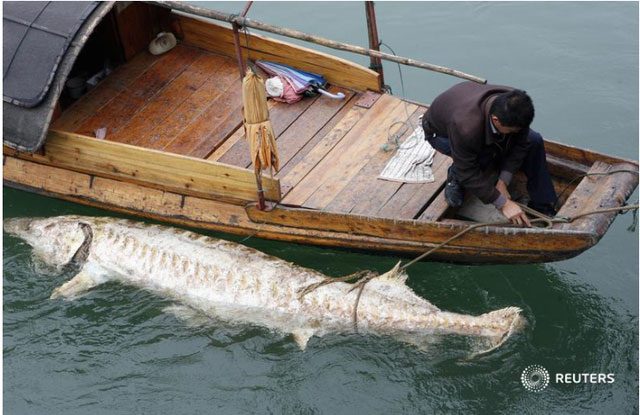The Yangtze River is not just home to one “monster fish” of such enormous size.
“Monster Fish” of the Yangtze River
Since January 1, 2021, China has banned all fishing activities in the main river, its tributaries, and large lakes within the Yangtze River system. The Yangtze River is the longest river in Asia and the third longest in the world, following the Amazon River in South America and the Nile River in Africa.

The Yangtze River is the longest river in Asia and the third longest in the world. (Image: Sohu).
The Yangtze River stretches approximately 6,380 km. It and the Huai River are considered the dividing line between northern and southern China. The Yangtze is the source of more cities than any other river in the world. It flows through various regions of China, including Qinghai, Tibet, Yunnan, Sichuan, Chongqing, Hubei, Hunan, Jiangxi, Anhui, Jiangsu, and Shanghai. It can be said that the waters of the Yangtze River sustain half of China’s population.
The Yangtze River boasts rich biodiversity and is home to many rare animal species, particularly many giant fish species characteristic of the river.

The Yangtze River is home to many fish and animal species. (Image: Sohu).
In fact, the Yangtze River has many fish weighing up to 90 kg. In 2018, a fisherman caught a catfish measuring 1.5 m in length and weighing over 50 kg. However, this was not the largest fish found in the area.

The giant catfish caught in the Yangtze River. (Image: Sohu).
In 1931, fishermen caught a “monster fish” measuring up to 8 m in length and weighing over 600 kg, requiring four men to carry it. It was a Yangtze sturgeon.
The Yangtze sturgeon (also known as the Chinese paddlefish) has long been dubbed the “king of freshwater fish in China.”
Yangtze sturgeons can grow up to 8 m and are very sensitive to noise in the river. The meat of the Yangtze sturgeon is considered a delicacy in China, and this fish is also caught for its roe.
By the early 1980s, it was classified as endangered and commercial fishing was banned due to a dramatic decline in its population. Since 1996, the Yangtze sturgeon has been listed as critically endangered by the IUCN.

The Yangtze sturgeon can grow up to 8 m. (Image: Sohu).
In addition to the Yangtze sturgeon, the baiji dolphin is also a giant fish found here. The Yangtze river dolphin (baiji) is often referred to as the “Goddess of the Yangtze River,” as it is believed to bring fortune and protect local fishermen, as well as anyone fortunate enough to see it.
The Yangtze river dolphin has a light gray color on its back and white on its belly. Its dorsal fin is light gray and triangular, resembling a flag when swimming, which gives it the nickname “white flag dolphin.”
This dolphin has a long snout and tends to increase in size, with a jaw containing around 31 to 36 conical teeth.

The baiji dolphin is also a giant fish found in the Yangtze River. (Image: Sohu).
Female dolphins are larger than males. Females range from 1.85 to 2.53 m in length and weigh between 64 and 167 kg. Males range from 1.41 to 2.16 m in length and weigh between 42 and 125 kg.
They are endemic to the Yangtze River. However, the population living and working in the Yangtze River basin is too large, causing significant pressure on the river. The construction of the Three Gorges Dam, along with various other large and small dam projects, has led to a shrinking habitat for the Yangtze river dolphin.
The Future of Fish Species in the Yangtze River
The Yangtze River once provided 60% of China’s freshwater fish, with an annual yield of approximately 100,000 tons. However, after decades of over-exploitation, species in this river such as the Yangtze river dolphin, the Yangtze sturgeon, and the paddlefish have been pushed to the brink of extinction.
As a result, a ten-year fishing ban on the Yangtze River was enacted to protect biodiversity and address the drastic decline in fish populations.

After decades of over-exploitation, fish species in the Yangtze River have been pushed to the brink of extinction. (Image: Sohu).
Currently, Chinese scientists are working to breed these extinct fish species from the Yangtze River and release them back into the wild.
As of now, it has been over two years since the ban was implemented. Will the Yangtze River still be home to these gigantic “monster fish”?
In 2023, when the Danjiangkou Dam was released, many large fish measuring over 1 m in length and weighing nearly 100 kg were spotted. It seems that the fishing ban on the Yangtze River is beginning to yield results. There is hope that in the future, the Yangtze River will welcome back these fish species.


















































